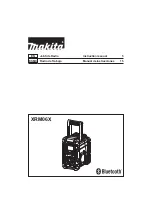
• BACK-END
IF signal goes through IF amplifier
Q704, C747, L716,& C748
and it matches with
U701
pin
16 (IF). U701 pin 1 feeds second local frequency
44.545MHz
, there are two signals coming
internal mixer. 2nd IF signal goes through U701 internal amplifier. And applies to
demodulator, which used a ceramic discriminator to detect audio signal. U701 pin 9 recovers
audio output. U701 pin12 supplies a received signal-strength indicator (RSSI) to
microprocessor (U102), RSSI supplied received signal strength level to shown on LCD
indicator. U701
functions have a noise amplifier and a noise detector level for
microprocessor to control the squelch. The noise signal comes from demodulator (U701
pin9), then pass through
R738
,
C761
and then applied to pin 8 through internal noise
amplifier. Noise detector supplies noise voltage for microprocessor (U101) to control squelch.
FREQUENCY SYNTHESIZER
• SYNTHESIZER
The PLL frequency synthesizer
U502
contains prescaler , phase detector, internal dividers,
reference counter, there are controlled by micro-controller Clock, Data, LE
VC-TCXO assures that the frequency remains stable across the temperature range (typically ±
2.5 ppm). besides VC-TCXO provide a modulation port for the sub tone modulation system.
The reference frequency (VC-TCXO) goes through U502 internal programmer to 2.5KHz or
3.125KHz, and then goes through phase comparator to gain a ØR signal from pin 16 (U502).
The VCO provides a feedback signal match to U502 (pin 8 F-in), the port including a pre-scale
N counter a counter,& swallow counter, to control VCO frequency divider to 2.5KHz or
3.125KHz. And then, goes through phase comparator to catch ØP signal output from pin5
(U502).
ØR
&
ØP
signals applied to charge pump Q503 Q502 controls the loop filter, whose circuit
consists of R514 C511. Then charge pump voltage pass to low pass filter, The low pass filter
consists of
R512 C512 R513 C513
, supply a necessary DC steering voltage for VCO to gain a
stable local-oscillation frequency.
• VCO
1.
RX VCO
The RX VCO includes transistor
Q602
, coil
L604, C611
, Varicap
CT601
and two varactors
D605
and
D606
, it is configured as a colpitts oscillator. its complexity comes from the
balance between wide band and low noise needs. the resonant circuit produces a different
frequency with a change in dc voltage controlled by the tuning voltage signal present at the
cathode of D605 and D606, the local oscillator signal is applied to the amplifier Q601. D601 is
a dual diode, when 1 of 2 is reverse biased the other one is forward biased. Due to D601, the
lo signal is applied to the mixer.
2.
TX VCO
The TX VCO comprises transistor
Q603
, Coil
L607
, Capacitor
C621
, Varicap
CT602
and
varactor
D603
and
D604
, it is configured as a colpitts oscillator. the resonant circuit produces
a different frequency with change in dc voltage controlled by the tuning voltage signal
present at the cathode of D603 and D604. the AF signal from R613 to the cathode of
D602
to
produce FM modulation, the signal is applied to amplifier
Q601
.
RX and TX power line filters transistor
Q606
is configured as a 5V power supply ripple filter,
the filter reduces the noise on the carrier and local oscillator signals.
VOLTAGE MULTIPLIER
Voltage multiplier circuit consist of IC (
U501
), diode (
D501, D502
),
R501, R502, C502,&
C503
. The DC/DC is set up to 10V. It goes through ripple filter (
Q501
) supply the charge
pump (
Q502, Q503
) to control TX/RX VCO. VCO controls RX front-end band pass filter switch
by
Q504
.
AUDIO UNIT
SCR SW
SCR_SW
RX AF_IN
• AUDIO FILTER
The audio output signal of the demodulator and scr sw provides to low pass filter circuit.
The circuit is composed of
C319, R317, C320, R318, R319, C321,& IC (U302A
), and then
applied to low pass filter, which is composed of
R320, C322, R321, C323, R322, C324,& IC
(U302B)
. The function of low pass filter is to attenuate 3KHz above audio signal.
• AUDIO AMPLIFIER
The audio signal is passed to low pass filter, which is composed of IC (
U302
), applied to audio
mute switch control , then passed to volume control (
VR301
), applied to audio amplifier
(
U301
), in the end, through
C318
to activate the speaker (
SP301
) by speaker jack (
J302
). The
audio output power is more than 0. 5W at 7% distortion.
• SQUELCH CONTROL CIRCUIT
The noise signal of the demodulator output goes through
R738, C761
, into a tank, which is
composed of
C760, L71
8, and then goes through
U701
internal noise amplifier, the noise
amplifier provide noise signal voltage from U701 pin13 is applied to MCU U101 pin29 (A/D)
sampling; in the end, by SQ SW (
U202
) pin11 to turn on transistors(Q302, Q303) and to
3
Summary of Contents for LIS 2013 FuG 13b
Page 1: ...LIS 2013 FuG 13b Service Manual 2 1 5 8 0 4 7 3 6 9...
Page 11: ...4 BLOCK DIAGRAM LOGIC CONTROL UNIT RF UNIT 5 SCHEMATIC POWER SUPPLY FRONT END 9...
Page 12: ...1ST IF MIXER SECOND IF AUDIO FILTER AUDIO AMPLIFIER 10...
Page 13: ...MODULATION SYNTHESIZER VCO TX BUFFER 11...
Page 14: ...RF POWER AMPLIFICATION 12...
Page 15: ...LOGIC CONTROL 13...
Page 16: ...PCB VIEW LOGIC BOARD 14...
Page 17: ...RF BOARD 15...
Page 25: ...7 EXPLOSION 23...






































